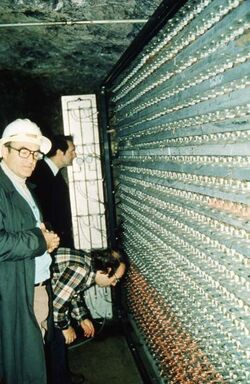Physics:Soudan 1

Soudan 1 was a particle detector located in the Soudan Mine in Northern Minnesota, United States, which operated for a year in 1981–82. It was a 30-ton tracking calorimeter whose primary purpose was to search for proton decay.[1] It set a lower limit on the lifetime of the proton of 1.6×1030 years as well as upper limits on the density of magnetic monopoles.[2] It also served as a prototype for the following Soudan 2 and MINOS experiments.
Design and operation
Soudan 1 was installed 590 meters below the surface and brought into routine operation in August 1981 by high-energy physics research groups from the University of Minnesota and Argonne National Laboratory. The detector was a 3×3×2m3 block of iron oxide-loaded concrete instrumented with 3456 gas proportional tubes. It was surrounded on five sides by a veto shield of solid scintillator, which was completed in October 1981. This allowed events which might otherwise have looked like proton decay, but were actually caused by cosmic rays, to be discarded. It had a total running time of 0.97 years.[3]
See also
References
- ↑ "The Soudan Nucleon Decay Program", D.S. Ayres, Presented at Workshop on Physics and Astrophysics with a Multikiloton Underground Track-Detector, Rome, Italy, Oct 29-31, 1981
- ↑ "Results From The Soudan Prototype Proton Decay Experiment" Ph.D. Thesis, John Eric Bartelt (Minnesota U.), UMI-84-13752, Mar 1984.
- ↑ Bartelt, J.; Courant, H.; Heller, K.; Joyce, T.; Marshak, M.; Peterson, E.; Ruddick, K.; Shupe, M. et al. (October 1987). "Monopole-flux and proton-decay limits from the Soudan 1 detector". Physical Review D 36 (7): 1990–2000. doi:10.1103/PhysRevD.36.1990. PMID 9958390. Bibcode: 1987PhRvD..36.1990B.
 |

